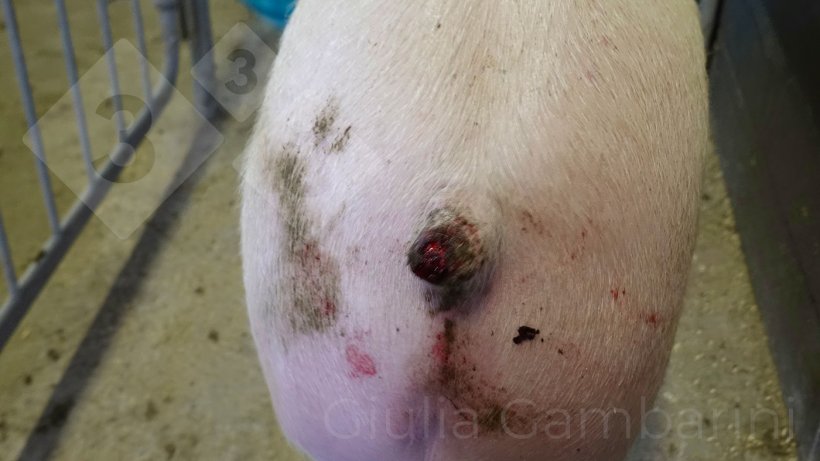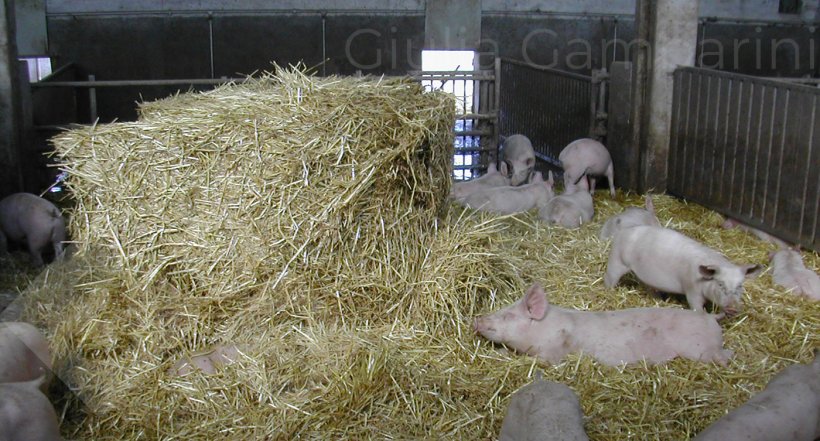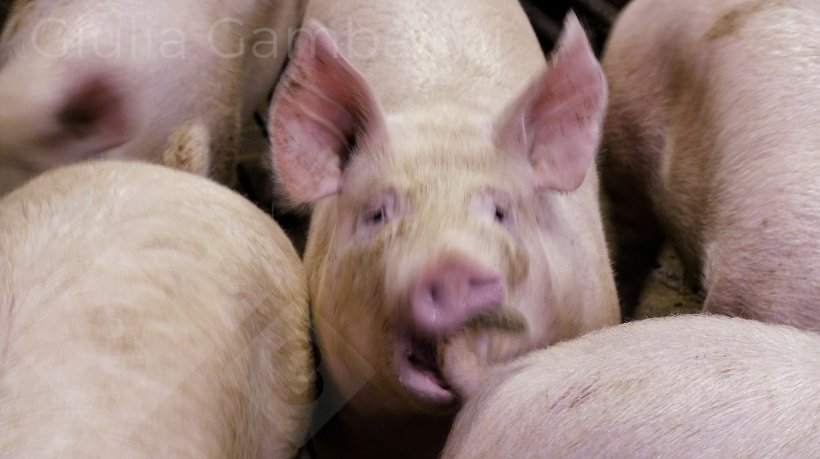Tail biting is a well-known issue in pig farming since it represents both an economic and an animal welfare problem (Schrøder-Petersen & Simonsen, 2001). In addition to being a sign of a distressing situation, tail biting itself causes stress and pain for the animals and can lead to infections and diseases. This also translates into economic losses due to the use of medications, reduced weight gain, and carcass depreciation (Arnott et al., 2014).

Photo 1. Tail lesions pose a risk of infection, with consequent economic losses for the producer.

From an ethological standpoint, it is a self-directed abnormal behavior of sporadic and unpredictable occurrence, whose risk factors are related to both the environment and the individual characteristics of the animals (Ursinus et al., 2014).
In general, tail biting events are triggered based on two key concepts (Valros A., 2017):
- Various risk factors increase stress levels in animals.
- High levels of stress affect several motivational systems, including those that regulate exploratory behavior, social behavior, feeding behavior, and thermoregulation.
More specifically, three different motivational drivers have been identified, each of which corresponds to a specific behavioral pattern (Taylor et al., 2010):
- Two-stage
- Sudden-forceful
- Obsessive
Two-stage pattern
This is the most studied model and is characterized by two phases, the first of which involves a pre-damage phase, while the actual lesions occur later. Initially, a pig manipulates another pig's tail with its mouth, without causing damage or provoking a reaction from the pig undergoing the manipulation (tail in mouth phase). Continued manipulation leads to the formation of small scratches or wounds, even serious ones, causing hemorrhages, and at this point, the attacked pig shows an avoidance reaction. The cause of this pattern seems to be the lack of a suitable substrate for exploratory behavior, which would lead the pig to explore its partner's tail as the only “material” available. Providing animals with adequate environmental enrichment may be a good preventive strategy, although it is unclear to what extent it may be effective in a situation where biting is already in progress. It is also advisable to remove the biting animal.

Photo 2. In the case of a two-stage pattern, the best preventive approach is to provide the animals with environmental enrichment that they can manipulate, e.g., straw.
Sudden-forceful pattern
The second pattern is less studied and is often described as cannibalism. This aggressive behavior is manifested by a sudden and violent bite, resulting in an immediate tail injury and the consequent reaction of the bitten animal. In this case, the cause appears to be a lack of access to resources. The preventive strategy is therefore to reduce competition for space, resting areas, food, drinking water, and enrichment. In this case, it may be advisable to remove the biting animal.
Video 1: To avoid triggering the sudden-forceful behavior pattern it is important to ensure that all pigs have access to resources, for example, providing adequate trough space.
Obsessive pattern
The third pattern occurs when a pig repeatedly grabs and pulls another pig's tail, eliciting a reaction from the victim. The biter performs this behavior repeatedly and persistently searches for a tail to bite, denoting obsessive behavior. The cause is unknown but could be related to the intrinsic characteristics of the subject, perhaps linked to the biter's protein metabolism or health status (Czycholl et al., 2023). Biting can be reduced by identifying and removing pigs with such tendencies.
Vídeo 2. The obsessive pattern seems to be related to individual characteristics, so the solution is removing the biting pigs.
Some researchers may have identified a fourth behavioral pattern, characterized by a sudden event causing both mild and severe tail damage that spreads rapidly within and between pens. It seems to be caused by sudden changes in the environment, e.g. feeding or temperature, which should therefore be avoided to prevent the phenomenon (Valros A., 2018).
Regardless of the type of pattern, it is clear that there is a significant attraction to blood (albeit with high individual variability), which would explain how even a minor injury increases the motivation to bite, even in pigs that did not cause the initial injury (Fraser, 1987). Imitation, which is fundamental in the pig's learning process, also plays a role in propagating the phenomenon.


Photo 3. Pig biting a penmate's tail.
Knowledge of the behavioral pattern is important in determining the type of intervention to adopt. Providing manipulable material, reducing competition for food and space, and, above all, early intervention as soon as the phenomenon is identified are crucial.








